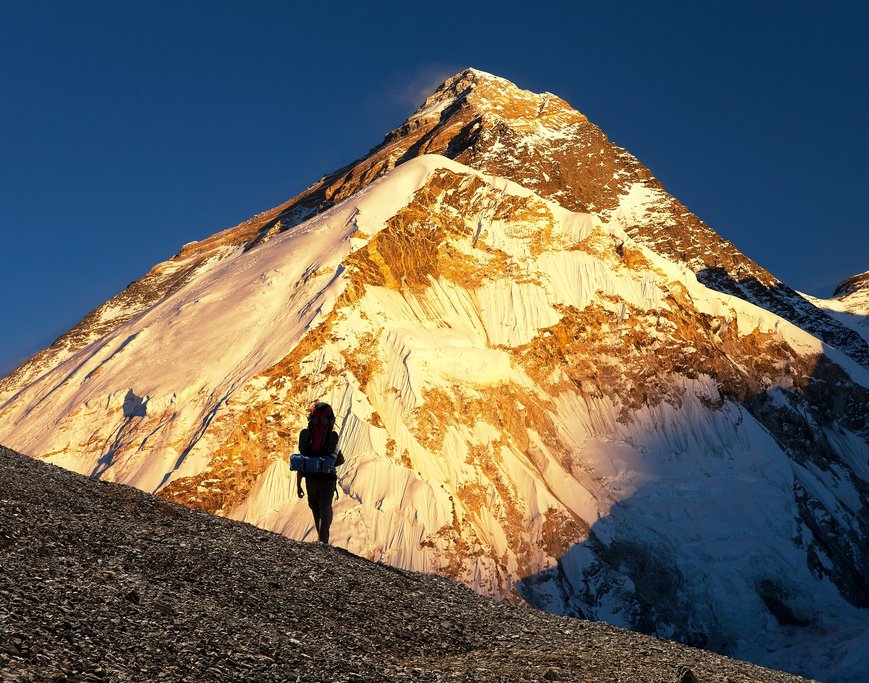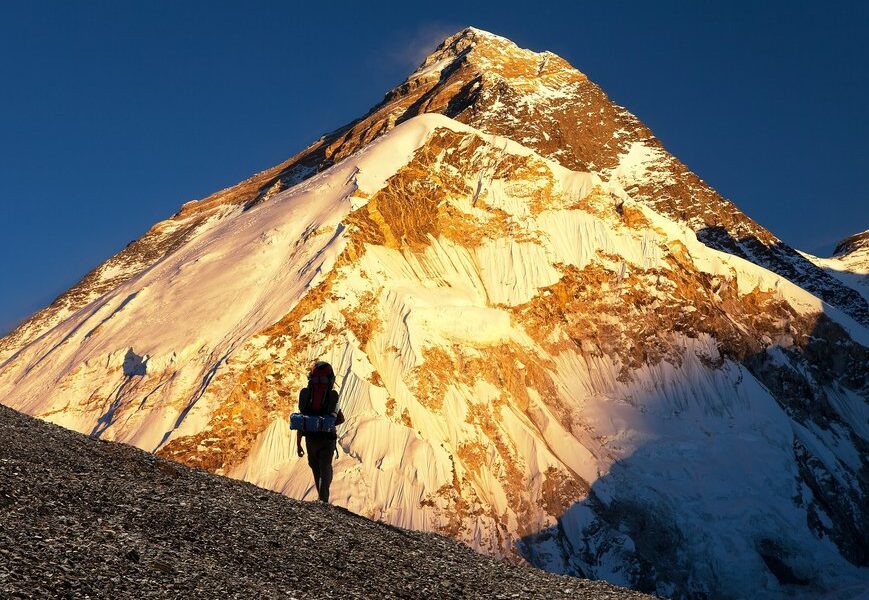
Many of the trekkers in the region this month have come here in hopes of summiting Mount Everest. Thus, trails to Everest Base Camp can get very congested in May. Unless you have your sights on the summit, we recommend trekking a quieter route in the area that allows you views of Base Camp and Everest, but without being in the thick of it.
Weather in the Everest Region in May
May in the Everest region presents a unique set of conditions for trekking enthusiasts. While the impending monsoon season looms just around the corner in June, May generally offers a window of opportunity for relatively favorable trekking weather. Temperatures are typically a bit warmer compared to April, making for a more comfortable experience during the day. For instance, in Namche Bazaar, you can expect an average high temperature of around 57°F or 14°C.
However, it’s important to note that rainfall tends to be slightly higher in May than in April, although it is still considered relatively low. As the month progresses, the humidity levels will rise noticeably as the region prepares for the monsoon. This increased humidity can sometimes obscure the breathtaking mountain views that the Everest region is so famous for. Trekkers should be aware of this potential impact on visibility.
Another weather phenomenon that you might encounter in late May is brief thunderstorms. While these storms might seem like a nuisance, they can actually be beneficial in the long run. The rainfall from the thunderstorms helps to clear the air of dust and haze, often resulting in clearer and more spectacular mountain views after the storm has passed. So, while you might need to take shelter for a short period, you could be rewarded with even better scenery.
It’s also worth mentioning that May marks the beginning of the Everest climbing season. This is because the conditions on the mountain itself are generally considered to be the most favorable for summit attempts during this time. However, it’s crucial to remember that the conditions experienced by climbers at extreme altitudes are vastly different from what trekkers will encounter at the lower altitudes more commonly traversed by hiking expeditions. The weather patterns and challenges faced by climbers are not necessarily representative of the trekking experience.
Crowds and Costs Associated with Trekking in May
The number of trekkers visiting Nepal typically begins to decrease throughout the month of May. This decline is primarily due to the increasing humidity and temperatures that precede the monsoon season. However, the trail leading to Everest Base Camp (EBC) is an exception to this general trend. The EBC trek remains popular in May due to the influx of mountaineers and support staff who come to the region for Everest expeditions.
Early to mid-May is generally considered the start of the climbing season, and expeditions often arrive well in advance to allow for proper acclimatization to the high altitude. As a result, the EBC trail and surrounding areas can become quite crowded during this period. This increased demand inevitably leads to higher costs for accommodation, food, and other services.
Flights from Kathmandu to Lukla, the gateway to the Everest region, are particularly affected by the climbing season. These flights tend to sell out well in advance, so it’s imperative to book your tickets as early as possible to secure your spot. Planning and booking ahead is essential to ensuring a smooth start to your trekking adventure.
Alternative Trekking Routes to Avoid the Crowds
If you’re not planning on climbing Everest itself, it’s advisable to avoid EBC in May due to the high concentration of people. However, don’t let this deter you from experiencing the beauty and majesty of the Everest region. There are numerous other remarkable trails in the area that offer similar experiences to the EBC trek without the overwhelming crowds.
One particularly appealing alternative is the trek to the Gokyo Lakes. This route branches off from the main trail and leads you towards a series of stunning turquoise glacial lakes. The Gokyo Lakes trek not only provides breathtaking scenery but also offers exceptional views of Everest and the surrounding peaks. It’s a great option for those seeking a more serene and less crowded experience.
For experienced trekkers looking for a more challenging adventure, the Three Passes trek is an excellent choice. This demanding route traverses three high passes in the region, offering unparalleled views and a true sense of accomplishment. The Three Passes trek requires a high level of fitness and experience, but the rewards are well worth the effort.
Another fantastic option is the Ama Dablam Base Camp trek. Ama Dablam is widely considered one of the most beautiful mountains in the world, and this trek allows you to get up close and personal with this iconic peak. Most trekkers only see Ama Dablam from a distance, but this trek takes you right to its base, offering a truly unforgettable experience.
Camping can be a great way to experience the Everest region, and the conditions in May are generally suitable for sleeping in a tent. The Gokyo Lakes trek and the Ama Dablam Base Camp trek offer numerous excellent camping spots. You don’t necessarily have to camp every night of your trip, but incorporating some camping into your itinerary can add a unique and memorable dimension to your adventure.
For those seeking a longer and more remote trekking experience, consider the Arun Valley to Everest Base Camp Trek. The Arun Valley is nestled between the Sagarmatha and Makalu-Barun National Parks, offering a diverse and less-traveled route. The trek commences in Tumlingtar, situated east of Everest, and eventually merges with the main EBC trail at Kala Pattar. It’s even possible to modify the standard route to avoid trekking to EBC altogether, allowing you to customize your experience.
May is also a suitable time to attempt a trekking peak if you’re looking for a greater challenge but don’t have the resources, skills, or desire to climb Everest. A trekking peak provides a good introduction to Himalayan climbing for those with prior high-altitude climbing experience. Island Peak, standing at 20,305 feet (6,189 m), presents a challenging yet not overly technical climb. The trek to Island Peak follows a similar path to the traditional EBC trek for a portion of the journey.
Similarly, Mera Peak, reaching a height of 21,246 feet (6,476 m), is Nepal’s highest trekking peak. The trek to Mera Peak is particularly noteworthy because it involves traversing the remote Hinku and Hongu Valleys. These valleys diverge from the main EBC trail before reaching Namche Bazaar, offering a unique and off-the-beaten-path experience. The treks to Island Peak and Mera Peak can be combined by crossing the high Amphu Labtsa Pass for an even more ambitious adventure.
Essential Items to Pack for a May Trek
When trekking in the Everest region in May, it’s essential to be prepared for a range of weather conditions while still packing efficiently. A good quality three-season sleeping bag is a must, as temperatures can drop significantly at night. A down jacket will provide essential warmth, especially at higher altitudes. Merino base layers are excellent for regulating body temperature and wicking away moisture. A reliable rain jacket is crucial for protection against potential showers or thunderstorms.
Getting to the Everest Region and Departing
The fastest and most convenient way to reach the Everest region is by flying from Kathmandu to Lukla. However, it’s important to be aware that these flights are frequently subject to delays or cancellations due to weather conditions or other factors in Kathmandu, Lukla, or along the flight path. The increasing humidity, smog, and dust in Kathmandu during May can further contribute to flight delays. Flights also tend to fill up rapidly, so it’s crucial to book well in advance. It’s always advisable to allow for some buffer days in your itinerary to avoid missing important international connections due to potential delays leaving Lukla.
Events Taking Place in May
The Tenzing Hillary Everest Marathon, promoted as ‘the world’s highest marathon’, takes place annually on May 29th. The date marks the anniversary of the first successful Everest summit in 1953. Participants have the option of running a 60 km, 42 km, or 21 km trail, all starting from EBC and winding through the Khumbu Valley. This marathon is a formidable challenge and should not be undertaken lightly!
Recommended Itineraries for Trekking in May
Consider these itineraries for trekking in May:
* Gokyo Lakes Trek – 16 Days
* Ama Dablam Base Camp Trek – 13 Days
* Arun Valley to Everest Base Camp – 26 Days
* **Climb Mera Peak: Nepal’s Highest Trekking Peak – 23 Days**
B-1707

